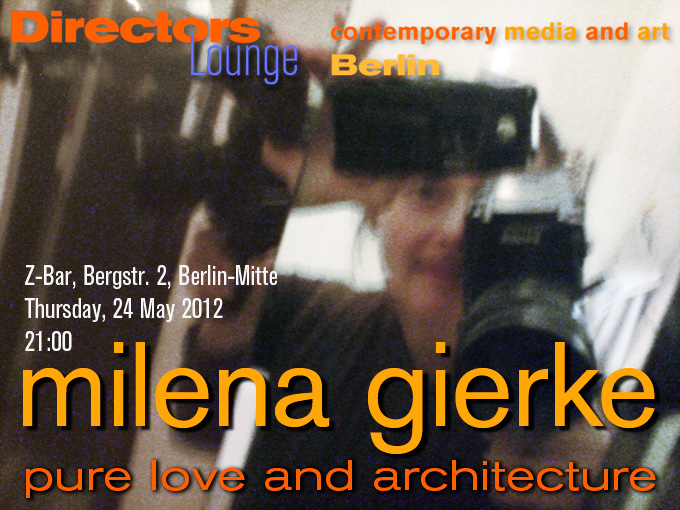directors lounge monthly screening
milena gierke
reine liebe und architektur
Filmabend mit Super-8 Filmen
Donnerstag, 24. Mai 2012
21:00 Uhr
Z-Bar
Bergstraße 2
10115 Berlin-Mitte
Architektur und Film sind in der Moderne eine signifikante Verbindung eingegangen. Dennoch erscheint die Verbindung von Super-8 Film und Architektur zunächst erstaunlich zu sein. Das Programm legt einen Schwerpunkt auf Architektur, wobei auch Filme über Menschen, Blumen und verborgene Winkel präsentiert werden. Schon fast eine Live-Performance zu nennen sind Super-8 Projektionen der Künstlerin Milena Gierke, die den Projektor selbst bedient und normalerweise für jede Veranstaltung eine neue Auswahl aus ihrem inzwischen über 75 Arbeiten umfassendem Filmarchiv zusammenstellt. Das Besondere an diesem Abend ist auch, dass die Auswahl für das Programm hauptsächlich vom Kurator ausging. Was Milena Gierkes Filme aber besonders auszeichnet, ist die mit dem liebevollem Blick für sprechende Details geführte Kamera und der organische Rhythmus der Bilder, der durch die Schnitte in der Kamera entsteht. Für den Betrachter setzen sich so aus den beobachteten Details Architekturen, Gebäude und menschliche Begegnungen zusammen.
Bis jetzt ist die Künstlerin der Super-8 Kamera, neben Malerei, Skulptur und Installation, treu geblieben. Der besonders kleine und praktische Schmalfilm in der Filmkassette, der 1965 von Kodak eingeführt wurde, zielte vor allem auf den Amateurmarkt des Heimkinos, wurde aber auch bald von Künstlern entdeckt, in der Zeit der Öffnung der Künste für die Medien in der 70ern. Nicht wegen der Qualität des Bildes und auch nicht aus ideologischer Überhöhung ist dieses Filmmaterial Gierkes bevorzugtes Medium geblieben, sondern für sie produktiv wurden die von ihr damit gewählten Beschränkungen: Ausreichend vorhandenes Licht, ein relativ kleines Filmbild, der in der Kamera geschnittene Film, der ihr erlaubt, ihre besondere organische Einheit von Bild, Szene und Schnittrhythmus zu erstellen, und die sehr kleine Handkamera ohne Stativ, die sehr mobil ist, aber keine langen Teleaufnahmen erlaubt. Frei nach dem Ausspruch von Robert Bresson “Die Fähigkeit mich meiner Mittel zu bedienen nimmt ab, wenn ihre Anzahl zunimmt", liegt hier die Freiheit der Filmkunst in der Beschränkung der Mittel. Die scharfe Auseinandersetzung mit der Frage, welche Szene oder welche Einstellung passt genau auf die zuvor gedrehten, schließlich führt die Künstlerin zu einer fast unglaublichen Ökonomie der Mittel: außer bei auftretenden technischen Problemen dreht sie “1:1"; kaum dass überflüssiges oder nicht brauchbares Material entsteht. Und es entstehen zugleich Filme mit klassischer Einheit von Handlung, Raum und Zeit, ja mehr noch, die einzelnen Filme entsprechen geradezu der ganzheitlichen Wahrnehmung von Raum und Zeit an einem Ort, in einer Situation. Jeder Film atmet, ist präsent, ist jetzt.
Noch etwas anderes zeichnet die Künstlerin aus, ihre Empathie zu ihrem Sujet, oder der “Situation", die sich der Kamera darbietet. Man spricht Elfi Mikesch eine besondere Intensität der Kamera zu; eine ähnliche Intensität erreicht Milena durch ihre besondere “Technik", die Liebe zum Sujet. Sie spricht davon, dass sie gegenüber der “Situation" den Part des “männlichen Liebhabers" einnimmt: die Szenerie muss “den ersten Schritt tun" sich zu öffnen, und Milena muss sich verlieben um mit dem Blick des Liebhabers, die Situation sich vor der Kamera entfalten zu lassen. Dies geschieht bei der Architektur, wie bei der Cité Radieuse von Le Corbusier in Marseille und bei La Muralla Roja von Ricardo Bofill genauso wie bei zeitgenössischen Bauruinen am Mittelmeer, oder einem verstecktem Schattenwinkel im Garten. Klatschmohn, andererseits bekommt architektonische Qualitäten. Gibt es eine Verbindung der Idee modernen Architektur und dem filmischen Blick, ohne die die Moderne sich vielleicht anders entwickelt hätte, so gibt es andererseits einen direkten Bezug zwischen menschlichen Begegnungen und der Kamera: das Zusammensein, die Parade, die Feier, waren von Anbeginn des Filmes schon bei den Brüdern Lumière besonders interessante Motive. Und so endet das Filmprogramm mit einer ganz besonderen kleinen Feier, dem 16. Geburtstag der Schwester der Künstlerin, auch hier mit liebevollem Blick festgehalten ein besonderes Kleinod, als auch der einzige Tonfilm im Programm.
Ein anderer Film, in der Mitte des Programms, “Fremder Mann II" könnte dagegen Schlüssel sein für eine komplexe Interpretation des intimen Blickes der Künstlerin und der eigenartigen Vertauschung der Geschlechterrollen, in der sie sich selbst sieht, wenn sie die Filmkamera in die Hand nimmt. Anlass des Films ist eine wilde Müllkippe im Süden Frankreichs, wo sich Reste von verlorenen oder abgelegten Träumen der Zweisamkeit finden, Bilder von Liebesromanen, Schlafzimmerausstattungen und Werbeprospekte. Dazwischen sucht ein einsamer Mann nach Brauchbarem. Er erscheint verschwitzt und arm, dennoch scheint er nicht nach Altmetall oder wiederverwertbarem Kunststoff, sondern nach etwas bestimmtem zu Suchen. Die Kamera folgt ihm aus der Distanz des interessierten aber fremden Beobachters. Die Geschichte bleibt offen, da wir nicht erfahren ob oder was er gefunden hat. Dennoch entsteht aus der Kombination der Bilder eine Spannung des Begehrens. Der Mann öffnet sich nicht gegenüber der Filmemacherin, obwohl er es zulässt, dass sie filmt. Die Situation als ganzes entfaltet sich dennoch in vielfältiger Weise für den Zuschauer. Zugleich bleibt die Begegnung flüchtig auch in der konservierten Form auf Zelluloid (das schon längst durch das weniger romantisch klingende Azetat abgelöst wurde). Die Künstlerin legt großen Wert auf die flüchtige Einmaligkeit des Filmschauens, und lehnt daher konsequenterweise auch das Veröffentlichen von Filmstills der Filme ab.
Auch aus diesem Grunde erwarten wir, dass die Veranstaltung mit Milena Gierke ein besonderes Ereignis wird. (Curator: Klaus W. Eisenlohr
Artist Link:
Director Milena Gierke:
http://www.regisseurinnenguide.de/vk.php3?user=57238
Curator Milena Gierke:
http://filmsamstag.de
Distribution: Arsenal
http://arsenal-berlin.de/
Links:
Directors Lounge
http://www.directorslounge.net
Z-Bar
http://www.z-bar.de
 Back Back
|


